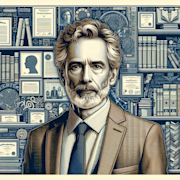The Silmarillion by J.R.R. Tolkien

In the world of fantasy literature, few works are as revered and iconic as “The Silmarillion” by J.R.R. Tolkien. This post will delve into the rich tapestry of stories and characters that make up this epic tome.
The Creation Myth
At the heart of “The Silmarillion” lies the creation myth of Tolkien’s fictional world, known as Arda. The book begins with the Ainulindalë, the Music of the Ainur, a beautiful and haunting melody sung by the divine beings known as the Ainur. This music gives rise to the physical world, with its continents, oceans, and inhabitants.
Tolkien’s creation myth draws heavily from various mythologies and religions, including Norse and Christian influences. The Ainulindalë sets the stage for the conflicts and wars that will shape the history of Arda, with themes of light versus darkness, good versus evil, and free will versus fate.
The Three Great Tales
“The Silmarillion” is divided into several sections, each focusing on different aspects of the history of Middle-earth. Among the most prominent are the three Great Tales: the story of the Elves, the tale of the Children of Húrin, and the account of Beren and Lúthien.
The Elves, known as the Firstborn, are central to much of the mythology of Middle-earth. Their history is marked by triumphs and tragedies, as they struggle to preserve their culture and way of life in the face of increasing darkness and evil.
The Children of Húrin, on the other hand, are mortal Men whose fates are entwined with those of the Elves. Their story is one of tragedy and heroism, as they battle against the forces of evil and strive to make their mark on the world.
Beren and Lúthien, perhaps the most famous of Tolkien’s love stories, is a tale of sacrifice, bravery, and undying love. It follows the adventures of a mortal man, Beren, and the Elf maiden, Lúthien, as they defy the will of the Dark Lord Morgoth in their quest to retrieve a Silmaril, one of the most prized jewels in Middle-earth.
The Fall of Morgoth
At the heart of “The Silmarillion” is the struggle against Morgoth, the first Dark Lord and the greatest enemy of the free peoples of Middle-earth. Morgoth’s lust for power and control drives much of the conflict in the book, as he seeks to dominate all of Arda and crush all who oppose him.
The Fall of Morgoth is a cataclysmic event that marks the end of an era in the history of Middle-earth. It is the culmination of centuries of warfare and strife, as the forces of good and evil clash in a final, apocalyptic battle that will determine the fate of the world.
Legacy and Influence
“The Silmarillion” stands as a testament to Tolkien’s imagination and world-building skills. The depth and complexity of the myths and legends he created have inspired countless other works of fantasy literature, as well as films, TV shows, and video games.
The themes of “The Silmarillion” – love, sacrifice, heroism, and the eternal struggle between light and darkness – continue to resonate with readers of all ages and backgrounds. Its characters and stories have become iconic in the world of fantasy fiction, cementing Tolkien’s legacy as one of the greatest storytellers of all time.
Conclusion
“The Silmarillion” is a work of unparalleled beauty and depth, a masterpiece of fantasy literature that continues to captivate readers around the world. Its timeless themes and unforgettable characters make it a must-read for any fan of Tolkien’s work, or indeed, any lover of epic tales and legends. Explore the rich tapestry of “The Silmarillion” and immerse yourself in a world of magic, wonder, and adventure.

Johnathan Evans
Journalist
More From Classics Authority Books

Book
Eragon by Christopher Paolini

Book
Whitman's Leaves of Grass: Celebrating the Poetic Tapestry of America

Book
The Fellowship of the Ring by J.R.R. Tolkien

Book
The Dark Side of Desire: Thomas Hardy's Tess of the d'Urbervilles

Book
A Farewell to Arms by Ernest Hemingway

Book
The Symbolic Commentary in Gabriel Garcia Marquezs Love in the Time of Cholera





